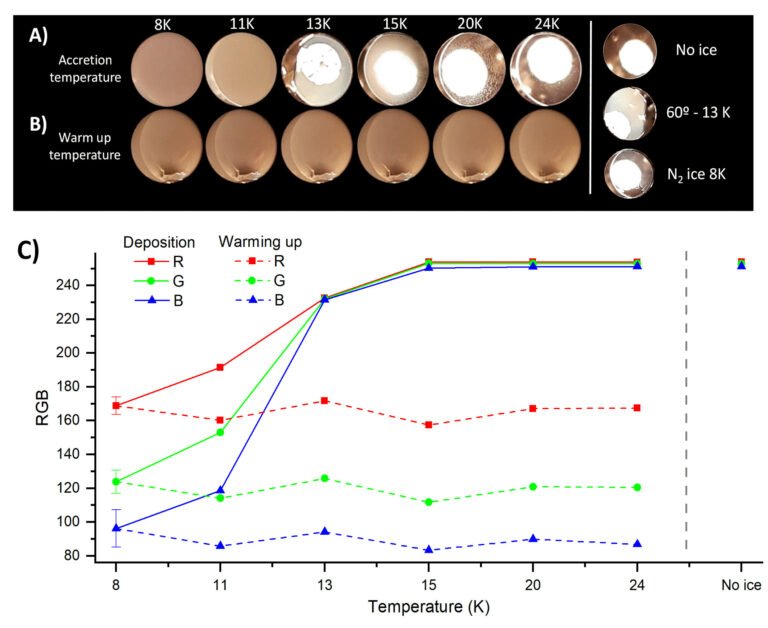Períod: 09/2021-09/2023
Funding Agency: MICINN
Project code: PID2020-118974GB-C21
PI: Guillermo M. Muñoz Caro, Miguel Á. Satorre Aznar (UPV Alcoy)
The main research topic of both institutions is the experimental study of astrophysical ice properties and processes. For this, vacuum set-ups are used to mimic the conditions in interstellar and circumstellar environments, along with icy moon surfaces. Ice analogs containing water and other simple molecules are grown at temperatures near 10 K and submitted to irradiation or warm-up. The techniques are:
1) The UPV team uses a high-vacuum (HV) set-up (10-8 mbar range) with a microbalance to weigh the microscopic ice samples, double laser interferometry to estimate the ice thickness, and a UV-Vis-NIR spectrometer, thus estimating the ice density and optical properties. The ice is also characterized during warm-up. A quadrupole mass spectrometer (QMS) is used to detect desorbing molecules in the gas phase.
2) The CAB team uses an ultra-high vacuum (UHV) set-up (10-11 mbar range) equipped with infrared and vacuum-ultraviolet spectrometers to monitor the ice. A QMS is used to detect desorbing molecules in the gas phase. In addition to controlled warm-up, this system performs ultraviolet (UV) irradiation of the ice using a hydrogen lamp.
This coordinated project allows a more complete study of ice processes and properties with a combination of the above techniques. The objectives of this proposal are the study of astrophysical ice analog properties, these are the density, porosity, optical indices, binding energies, and ice thermal properties. The evolution of these paramaters, during ultraviolet irradiation or warm-up, traces the structural and chemical evolution of the ice samples. Therefore, this proposal attempts to study the link between the ice properties and the ice processes. In the case of water ice, the warm-up process involves a slow transition between different structures of amorphous and crystalline ice. These processes shape the ice morphology, and therefore, the interaction of water with other molecules embedded in the ice (CO, CO2, CH4, CH3OH, NH3, etc.). Diffusion and thermal desorption of species in the water-dominated ice will be studied. When UV-irradiation of the ice is applied, also the photochemistry and photon-induced desorption processes will be explored.
The end result of multicomponent ice samples irradiation and warm-up is the formation of complex organic molecules (COMs) that allow comparison with the COMs observed in the gas toward regions where icy dust underwent similar processes, e.g. hot cores and protoplanetary disks. This project is expected to coincide with the advent of the first ice observations with JWST. The first round of observing JWST proposals was submitted in Nov. 2020. Our laboratory ice database will thus serve for the interpretation of the JWST observations.








